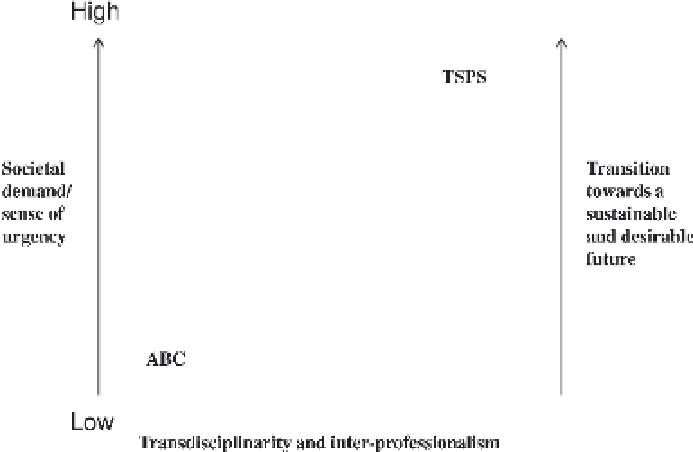Environmental Engineering Reference
In-Depth Information
Figure 22.5
The path toward sustainability in an increasingly non-analogue future. ABC, autonomous, basic and curiosity-
driven research; and TSPS, transdisciplinary science and problem solving.
we wish to move away from the precipice of ecological
and environmental crisis we have come to. As the
inventor Buckminster Fuller put it, several decades ago,
we need a 'new operating manual for Spaceship Earth'.
In Figure 22.5, we illustrate a blueprint for
sustainability - science - in - action. Problem solving
requires, fi rst of all, a fundamental scientifi c analysis,
using available tools from all the appropriate sciences
in the group we call ABC (autonomous, basic and
curiosity-driven), while at the same time evaluating
these tools according to their applicability to the
problem. Depending on the disciplines, stakeholders
and urgency factor involved, the way towards problem
solving is straightforward or roundabout. Intermediate
solutions and/or reports may be useful as well. Of
course, we recognize that there is feedback from
problem solving back towards the ABC sciences, as
many of the scientifi c problems taken into account are
inspired by societal problems. The ultimate test of
success in this dynamic fi eld is whether the world is
getting more - or less - sustainable. Not only our well-
being but also our survival depends on it.
the link or the bridge between sustainable economic
development objectives and nature conservation ones.
Many communities, NGOs, individual nations and
multinational corporations are now actively investing
in, or encouraging investment and legislation for, eco-
logical restoration; several international organizations
and treaties (CBD, UNFCCC and UNCCD) and the Euro-
pean Commission, are going further still, by embracing
the paradigms that describe natural capital as the vital
factor required to guarantee the fl ow of ecosystem
services (see also Com í n 2010) .
We hope we have shown that restoration is vital to
maintaining biological diversity, to adaptation and
mitigation in the face of climate change and deserti-
fi cation, and to improving the quality of ecosystem
services to the benefi t of human welfare across the
globe. We would like to conclude with an account
of an exemplary project that illustrates the capacity
and potential of restoration to achieve these goals
when a collaborative approach is taken by a transdis-
ciplinary team of scientists, professionals and volun-
teers, working in conjunction with local communities
and landowners. In Box 22.2, we introduce an excel-
lent example of this kind of interaction, within a large-
scale restoration programme addressing the subtropi-
cal thicket biome in South Africa. We think this project
represents an example of a
modus operandi
that should
be applied, adapted and tested in many countries in
coming years.
22.4 EPILOGUE
In closing, let us recall the discussion of natural capital,
ecosystem services and transdisciplinarity in Chapter
2, and the idea that ecological restoration can provide






























